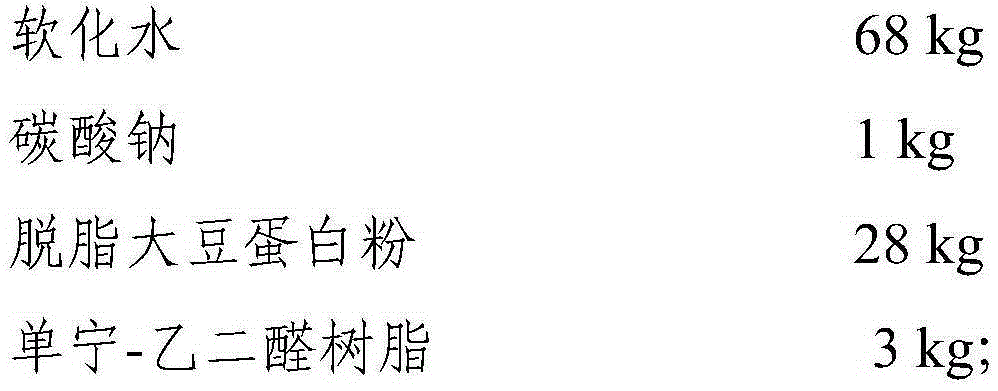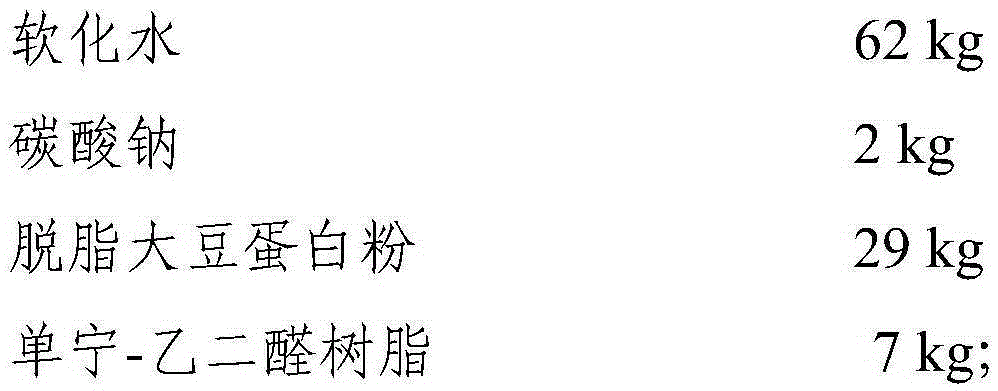Adhesive for wood-based panels and its preparation method and application
A technology for adhesives and wood-based panels, applied in the preparation of adhesives, animal glue or gelatin, adhesive types, etc., can solve the problems of increased production costs, increased product costs, and reduced bonding strength, so as to save production costs and meet water resistance requirements. Requirement, effect of guaranteeing bonding strength
- Summary
- Abstract
- Description
- Claims
- Application Information
AI Technical Summary
Problems solved by technology
Method used
Image
Examples
Embodiment 1
[0053] 1) Prepare materials according to the following weight:
[0054]
[0055] 2) Add sodium carbonate and defatted soybean protein powder into demineralized water in a reaction kettle equipped with a stirrer, thermometer and condensing device, and stir evenly;
[0056] 3) Heat the obtained mixture of sodium carbonate, defatted soybean protein powder and demineralized water to 45-47°C and keep it warm for 3 hours;
[0057] 4) Cool down the mixture obtained in the previous step to 30°C to obtain a uniform soy protein mucus;
[0058] 5) Add tannin-glyoxal resin to the soy protein mucilage obtained in the previous step, and stir evenly to make a soy protein adhesive for wood-based panels.
[0059] The performance and quality indicators of the obtained adhesive are shown in Table 1.
Embodiment 2
[0061] 1) Prepare materials according to the following weight:
[0062]
[0063] 2) Add sodium carbonate and defatted soybean protein powder into demineralized water in a reaction kettle equipped with a stirrer, thermometer and condensing device, and stir evenly;
[0064] 3) Heat the obtained mixture of sodium carbonate, defatted soybean protein powder and demineralized water to 4042°C and keep it warm for 6 hours;
[0065] 4) Cool down the mixture obtained in the previous step to 30°C to obtain a uniform soy protein mucus;
[0066] 5) Add tannin-glyoxal resin to the soy protein mucilage obtained in the previous step, and stir evenly to make a soy protein adhesive for wood-based panels.
[0067] The performance and quality indicators of the obtained adhesive are shown in Table 1.
Embodiment 3
[0069] 1) Prepare materials according to the following weight:
[0070]
[0071] 2) Add sodium carbonate and defatted soybean protein powder into demineralized water in a reaction kettle equipped with a stirrer, thermometer and condensing device, and stir evenly;
[0072] 3) Heat the obtained mixture of sodium carbonate, defatted soybean protein powder and demineralized water to 68-70°C and keep it warm for 5 hours;
[0073] 4) Cool down the mixture obtained in the previous step to 30°C to obtain a uniform soy protein mucus;
[0074] 5) Add tannin-glyoxal resin to the soy protein mucilage obtained in the previous step, and stir evenly to make a soy protein adhesive for wood-based panels.
[0075] The performance and quality indicators of the obtained adhesive are shown in Table 1.
[0076] In Table 1, the unit "%" of solid content and free formaldehyde content is mass percentage.
[0077] Table 1: Performance and quality indicators of adhesives
[0078]
[0079] It c...
PUM
| Property | Measurement | Unit |
|---|---|---|
| viscosity | aaaaa | aaaaa |
Abstract
Description
Claims
Application Information
 Login to View More
Login to View More - R&D
- Intellectual Property
- Life Sciences
- Materials
- Tech Scout
- Unparalleled Data Quality
- Higher Quality Content
- 60% Fewer Hallucinations
Browse by: Latest US Patents, China's latest patents, Technical Efficacy Thesaurus, Application Domain, Technology Topic, Popular Technical Reports.
© 2025 PatSnap. All rights reserved.Legal|Privacy policy|Modern Slavery Act Transparency Statement|Sitemap|About US| Contact US: help@patsnap.com



